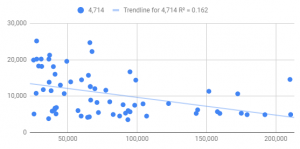Big Data in the MSU Libraries
 While the label “big data” makes us think of major technology companies, the MSU Libraries collects and evaluates many points of data as well. The library technical infrastructure is constantly gathering data about services, collections, and spaces, and library employees are regularly adding to and enhancing those data.
While the label “big data” makes us think of major technology companies, the MSU Libraries collects and evaluates many points of data as well. The library technical infrastructure is constantly gathering data about services, collections, and spaces, and library employees are regularly adding to and enhancing those data.
When people use the MSU Libraries web page, Missouri State Digital Collections, or MSU Libraries’ YouTube channel, Google Analytics counts their visit and tracks their behavior while maintaining patron privacy. Later the data are used to determine which website destinations are most popular. For example, Special Collections uses popularity information to help determine which collections to digitize next. In a similar fashion, as patrons enter the Meyer Library building, cameras count their entry and those data are used to help determine library hours and staffing levels. The library evaluates material acquisitions yearly based on patron use of those materials and cost to keep them available. Library catalog functionality works only because of the extensive metadata created and curated over many years.
When patrons ask research questions through Ask-A-Librarian, the person who answers the question adds extra metadata for use later. Such data inform librarians about current student assignments, content needs, and discovery service use. Sometimes the metadata quickly informs decisions, but many times librarians use it later when determining how to setup a service, what to add to a subject guide, or what to include in an instruction session.
Since 2015, the MSU Libraries have used Key Performance Indicators (KPI) to help make data-informed decisions. A group of spreadsheets track the indicators and present data in time series and summary tables. Charts display longitudinal or year over year views. Statistical analysis provides numbers such as standard deviation, coefficient of variation and correlation measures as well as charts that help to interpret the correlation.
Last year, the MSU Libraries adopted the FOLIO software platform and soon after that, became a beta partner for EBSCO Analytics, later renamed Panorama. By using Panorama, we soon hope to see a more unified interface for accessing much of the data we use.